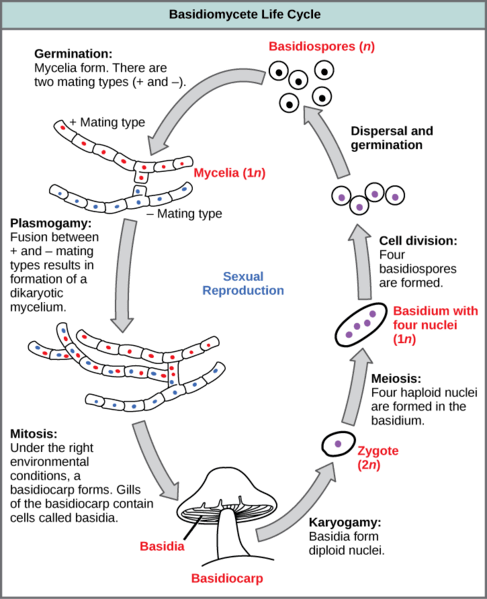Difference Between Plasmogamy and Karyogamy
Table of Contents
Key Difference – Plasmogamy vs Karyogamy
Fertilization is a major stage in the sexual reproductive cycle of eukaryotic organisms. During fertilization, two gametes are fused with each other to produce a diploid zygote which later becomes the new individual. The fusion of two gametes during fertilization is known as syngamy. Syngamy can be divided into two stages named plasmogamy and karyogamy. Plasmogamy occurs first and is followed by karyogamy. In some organisms, these two occur simultaneously while in some species karyogamy is delayed for a considerable time duration. The key difference between plasmogamy and karyogamy is that plasmogamy is the fusion of cell membranes and cytoplasm of two cells without the nuclei fusion while karyogamy refers to the fusion of two haploid nuclei to produce a diploid cell.
CONTENTS
1. Overview and Key Difference
2. What is Plasmogamy
3. What is Karyogamy
4. Side by Side Comparison – Plasmogamy vs Karyogamy in Tabular Form
5. Summary
What is Plasmogamy?
The fusion of male and female gametes occurs in sexual reproduction in order to produce a diploid zygote. This is known as fertilization or syngamy. Prior to haploid nuclei fusion, cell membranes of the two gametes fuse and the two cytoplasm fuse with each other. The nuclei fusion delays for a certain time period. This process is known as plasmogamy. Plasmogamy is feasible among two gametes or between two vegetative cells of fungi which play the role of gametes. Plasmogamy is one stage of sexual reproduction in fungi and it brings two nuclei close to each other for fusion. Plasmogay creates a new cell stage which differs from normal haploid or diploid cell since it contains both male and female nuclei coexisting within the same cytoplasm without merging as n+n state. At this phase, the resulting cell is called dikaryon or dikaryotic cell. Dikaryotic cell harbors a couple of nuclei from the two mating types.

Figure 01: Plasmogamy
What is Karyogamy?
Karyogamy is the step which makes the diploid zygote. Two haploid nuclei fuse with each other to produce diploid zygote. Karyogamy occurs after the fusion of the two cytoplasms. This fusion of two nuclei produces a diploid cell, which has a mixture of two types of genetic materials.
Plasmogamy and karyogamy are clearly visible stages in fungal sexual reproduction. Fungi reproduce through plasmogamy, karyogamy, and meiosis. Those are the main stages of fungal sexual reproduction. This dikaryotic stage is prominent in most fungi and, in some fungi, it exists up to several generations. However, in lower fungi, karyogamy occurs immediately after the plasmogamy.
Ascomycota is a group of macrofungi which shows distinct phases of plasmogamy, karyogamy, and meiosis during sexual reproduction. The mating of two types of hyphae produces dikaryotic (n+n) phase due to plasmogamy. Afterward, karyogamy occurs and produces a diploid zygote. The diploid zygote then divides into eight ascospores by two meiotic divisions.

Figure 02: Karyogamy (Stage 4)
What is the difference between Plasmogamy and Karyogamy?
Plasmogamy vs Karyogamy | |
| Plasmogamy refers to the fusion of the cytoplasm of two gametes or to two vegetative cells which work as gametes. | Karyogamy refers to the fusion of two nuclei during fertilization. |
| Nuclei Fusion | |
| Nuclei are not merged during plasmogamy. | Nuclei are fused with each other to produce a zygote. |
| Resultant Cell | |
| Plasmogamy produces a dikaryotic cell which possesses n+n state (containing two types of haploid nuclei). | Karyogamy produces a 2n cell called the diploid zygote. |
| Followed by | |
| Plasmogamy occurs after meiosis | Karyogamy occurs after plasmogamy |
| Stage of Syngamy | |
| Plasmogamy is the first stage of syngamy. | Karyogamy is the second stage of syngamy. |
Summary – Plasmogamy vs Karyogamy
The fusion of two gametes during sexual reproduction is known as syngamy. Syngamy occurs via two stages named plasmogamy and karyogamy. Plasmogamy is the first stage of syngamy. It is the fusion of the cytoplasm of two gametes or two mating cells without the fusion of their nuclei. Plasmogamy brings the male and female nuclei together. When plasmogamy occurs, it produces a cell which contains two nuclei inherited from each parent and the cell is known as a dikaryotic cell. After the fusion of cytoplasm, two nuclei come closer and fuse with each other. This stage is known as karyogamy. This is the difference between plasmogamy and karyogamy. Once karyogamy occurs, it yields a diploid cell called zygote. The zygote can divide by meiosis to produce spores or it can divide by mitosis to produce a new individual. In some organisms, karyogamy occurs immediately after the plasmogamy as in lower fungi. In some species, dikaryon phase exists for several generations.
Download PDF Version of Plasmogamy vs Karyogamy
You can download PDF version of this article and use it for offline purposes as per citation notes. Please download PDF version here Difference Between Plasmogamy and Karyogamy
Reference:
1. “Environmental Microbiology: Fundamentals and Applications.” Google Books. Available here. N.p., n.d. Web. 03 June 2017.
2. “Karyogamy.” Wikipedia. Wikimedia Foundation, 03 Apr. 2017. Web. Available here. 03 June 2017.
Image Courtesy:
1. “Figure 24 02 07” By CNX OpenStax – (CC BY 4.0) via Commons Wikimedia
2. “Karyogamy” By Donbinincom – Own work (CC BY-SA 3.0) via Commons Wikimedia
ncG1vNJzZmivp6x7pbXFn5yrnZ6YsqOx07CcnqZemLyue8OinZ%2Bdopq7pLGMm5ytr5Wau268y5qqpqeXlrq6ecCnm2auo2K4or7YqJ6apalk